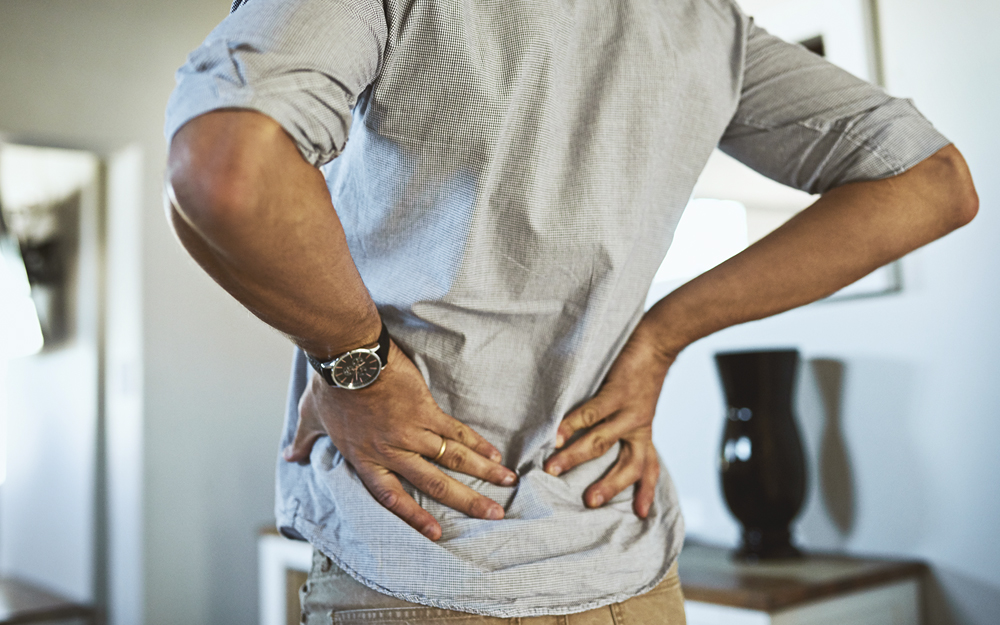Cedars-Sinai Blog
Treating Back Pain Without Surgery
Oct 23, 2019 Antonio Gonzalez

About 80% of people will experience back pain at some point in their life according to the National Institutes of Health.
Searching for a solution can be a frustrating journey, with periods of relief followed by sudden discomfort.
"Surgery is usually only considered when all other options have been exhausted. For most people, there are many noninvasive or minimally invasive treatments that can relieve pain."
Thankfully, there are nonsurgical options to treat back pain for most people, says Dr. Jason Berkley, a neurologist and back pain specialist.
"Surgery is usually only considered when all other options have been exhausted," Dr. Berkley says. "For most people, there are many noninvasive or minimally invasive treatments that can relieve pain."
Medication-free treatments
Chronic back pain—defined as pain that lasts for 3 months or more—typically starts from a muscle strain as a result of lifting, overuse, or an accident.
Other conditions such as arthritis, osteoporosis, obesity, and disc problems also can cause chronic back pain.
Doctors often suggest medication-free treatments like these as the first step in addressing chronic back pain:
- Physical therapy – Working with a physical therapist to improve posture, strength, and flexibility through stretches, movement, and core exercises can reduce back pain.
- Acupuncture, acupressure, and massage therapy – Tiny needles or hand pressure can reduce tension, relieve joint pain, and speed up recovery from an injury.
- Aquatic/water therapy – Water counteracts gravity, so pools create a desirable environment to perform exercises that improve flexibility, balance, and strength.
- Nutrition/lifestyle changes – Obesity often increases pressure on the spine and on the discs, which provide padding between the bones that form the spinal column. Studies also show smoking is linked to increased back pain.
- Cupping – Suction cups against the skin may help increase or decrease blood flow, reduce pain, and shorten recovery time, though more studies are needed to know their effectiveness.
- Osteopathic manipulation – Specially trained physicians can perform gentle pressure, resistance, and stretching to relieve joint discomfort and improve muscle balance and blood flow.
Cedars-Sinai Magazine: Mind, Body, Spirit Medicine - A Holistic Approach to Optimal Health
Injections
If those treatments alone are not enough, injections can provide another avenue for pain relief.
Injections are often recommended after an MRI or other imaging confirms what is found during a physical examination, Dr. Berkley says, and they are often used to help with physical therapy.
Besides reducing pain, injections can help identify the source of pain. They are usually administered in an outpatient setting, meaning patients go home on the same day.
Among the most common injections:
- Epidural steroid injection – a cortisone (steroid) solution delivered directly to the spine, reducing swelling and irritation around a nerve or part of the spinal cord
- Selective nerve root injection – medication is injected into a particular nerve, rather than the entire spine, using X-ray guidance
- Facet joint injection – medication is injected directly into a facet joint, which links the spinal bones together, with the help of X-ray guidance
- Sacroiliac joint injection – an injection into the joint that connects the tailbone to the pelvis, which is a common source of lower back and leg pain
- Joint and soft tissue injection – a steroid or pain reliever injected directly into a specific joint or soft tissue area to provide pain relief that can last for weeks or months
- Radiofrequency ablation – also known as a rhizotomy, this procedure uses radio waves to generate heat that can kill pain-causing tissue
In the Newsroom: Cedars-Sinai Expert: Try Non-Opioid Solutions to Pain Management
Medications
Anti-inflammatory drugs that can be purchased without a prescription—such as aspirin, ibuprofen, and acetaminophen—can provide short-term relief for back pain, but can cause serious kidney and stomach issues with long-term use.
The same goes for cannabidiol (CBD) and cannabis (marijuana), which are legal for recreational and medical use in California and several other states, but have the potential for dangerous side effects, particularly when used with other medications.
Prescription painkillers can be highly addictive and should only be used for short periods, such as after a surgery or immediately following a major accident or injury.
"You should always contact your doctor before taking any medication," Dr. Berkley says. "If pain becomes worse or begins to interfere with daily activities, you should let your doctor know.”
"If nothing is making a difference and there is imaging that correlates with the pain, maybe then we would say, 'Hey, this is something that is surgical and you should see the surgeon.' But surgery is rarely a first-line option."



